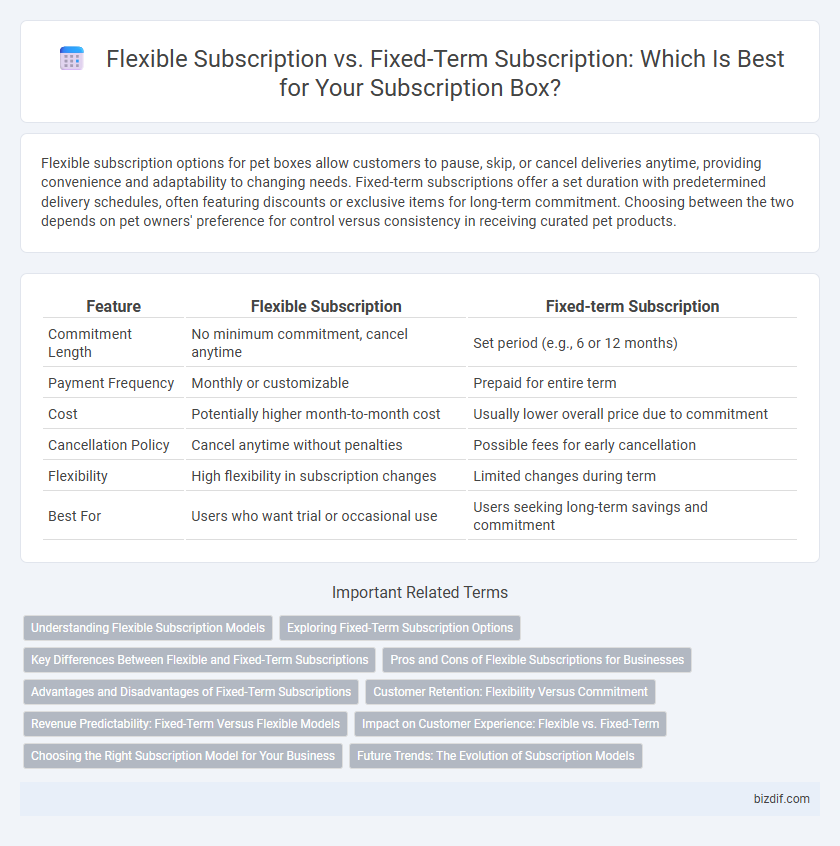Flexible subscription options for pet boxes allow customers to pause, skip, or cancel deliveries anytime, providing convenience and adaptability to changing needs. Fixed-term subscriptions offer a set duration with predetermined delivery schedules, often featuring discounts or exclusive items for long-term commitment. Choosing between the two depends on pet owners' preference for control versus consistency in receiving curated pet products.
Table of Comparison
| Feature | Flexible Subscription | Fixed-term Subscription |
|---|---|---|
| Commitment Length | No minimum commitment, cancel anytime | Set period (e.g., 6 or 12 months) |
| Payment Frequency | Monthly or customizable | Prepaid for entire term |
| Cost | Potentially higher month-to-month cost | Usually lower overall price due to commitment |
| Cancellation Policy | Cancel anytime without penalties | Possible fees for early cancellation |
| Flexibility | High flexibility in subscription changes | Limited changes during term |
| Best For | Users who want trial or occasional use | Users seeking long-term savings and commitment |
Understanding Flexible Subscription Models
Flexible subscription models allow customers to modify, pause, or cancel their subscription at any time, catering to individual preferences and enhancing user convenience. These models often provide options to skip shipments, change product selections, or adjust delivery frequency, promoting a personalized customer experience. Unlike fixed-term subscriptions, flexible plans reduce commitment risk, improving customer retention and satisfaction through adaptable service offerings.
Exploring Fixed-Term Subscription Options
Fixed-term subscriptions offer customers a predetermined commitment period, typically ranging from three to twelve months, ensuring a consistent delivery schedule and often providing cost savings or exclusive perks. These subscriptions foster customer loyalty and predictability for subscription box services, allowing for better inventory planning and reduced churn rates. Exploring fixed-term options can attract subscribers seeking reliability and value without the uncertainty of monthly cancellations.
Key Differences Between Flexible and Fixed-Term Subscriptions
Flexible subscriptions offer customers the ability to pause, skip, or cancel deliveries at any time, providing greater control over their purchase schedule. Fixed-term subscriptions require a commitment for a predetermined period, often resulting in discounted rates but less adaptability. The primary differences lie in contract length, cancellation policies, and payment structures, catering to varying consumer preferences for convenience or stability.
Pros and Cons of Flexible Subscriptions for Businesses
Flexible subscriptions allow businesses to adapt offers based on customer preferences and market trends, enhancing customer retention and lifetime value. These subscriptions often simplify inventory management and reduce churn by enabling easy plan modifications but can create revenue unpredictability and complicate financial forecasting. Managing flexible subscriptions requires robust data analytics and customer support systems to balance customization benefits with operational efficiency.
Advantages and Disadvantages of Fixed-Term Subscriptions
Fixed-term subscriptions offer the advantage of predictable billing cycles and commitment incentives, often providing discounts or exclusive content unavailable in flexible plans. However, their rigidity can lead to customer dissatisfaction if needs change, as cancellations or modifications typically incur penalties or are not allowed mid-term. Businesses benefit from stable revenue forecasts but risk higher churn rates when customers are locked into inflexible agreements.
Customer Retention: Flexibility Versus Commitment
Flexible subscriptions boost customer retention by offering adjustable delivery schedules and easy plan modifications, catering to changing needs and reducing churn rates. Fixed-term subscriptions establish commitment through set durations, often incentivizing longer engagement but risking cancellations if customer preferences shift. Balancing flexibility with commitment enhances customer satisfaction and loyalty by aligning subscription models with diverse consumer behaviors.
Revenue Predictability: Fixed-Term Versus Flexible Models
Fixed-term subscriptions provide higher revenue predictability by securing customer commitments over a set period, enabling accurate forecasting and inventory management. Flexible subscriptions offer greater customer satisfaction through adjustable plans but introduce variability in monthly revenue streams, complicating financial projections. Businesses must balance fixed-term reliability with flexible appeal to optimize subscription revenue strategies.
Impact on Customer Experience: Flexible vs. Fixed-Term
Flexible subscriptions enhance customer experience by allowing users to adjust, pause, or cancel deliveries based on changing preferences, fostering convenience and satisfaction. Fixed-term subscriptions provide a structured, predictable schedule that appeals to customers seeking consistency and commitment, but may lead to frustration if needs evolve unexpectedly. Offering tailored options between flexible and fixed-term plans can increase retention and meet diverse consumer demands effectively.
Choosing the Right Subscription Model for Your Business
Flexible subscriptions offer businesses adaptability with month-to-month billing, allowing customers to pause or cancel anytime, which enhances customer retention and satisfaction. Fixed-term subscriptions provide predictable revenue streams and enable easier forecasting by locking customers into a defined period, such as six months or a year. Choosing between these models depends on your business goals, customer behavior, and cash flow stability requirements.
Future Trends: The Evolution of Subscription Models
Flexible subscriptions are gaining traction as consumer demand shifts towards customizable and on-demand services, enabling users to pause, modify, or cancel plans without penalties. Data from market analysts indicate a significant rise in flexible subscription adoption, projected to grow by 25% annually over the next five years. Fixed-term subscriptions remain popular for steady revenue streams, but future trends suggest hybrid models combining flexibility with fixed commitments will dominate the evolving subscription economy.
Flexible subscription vs Fixed-term subscription Infographic

 bizdif.com
bizdif.com